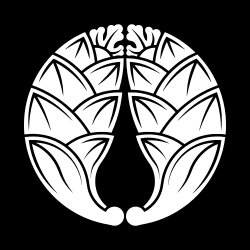茗荷
Japanese


Etymology 1
| Kanji in this term | |
|---|---|
| 茗 | 荷 |
| みょう Hyōgai |
が Grade: 3 |
| on'yomi | |
| Alternative spelling |
|---|
| 蘘荷 (rare) |
/meɡa/ → /meuɡa/ → /mjoːɡa/
From earlier mega (see below). The kanji spelling is an example of phonetic ateji.
Pronunciation
Noun
茗荷 or 茗荷 • (myōga) ←めうが (meuga)?
- myoga or Japanese ginger (Zingiber mioga), of which only the shoots and flower buds are used in cooking
- a dimwit, an idiot, a stupid person (from a folk belief that excess consumption of myoga causes forgetfulness)
- a kind of 家紋 (kamon, “family crest”)
Usage notes
As with many terms that name organisms, this term is often spelled in katakana, especially in biological contexts (where katakana is customary), as ミョウガ (myōga).
Derived terms
- 茗荷の子 (myōga no ko): a myoga flower; a loss when gambling
- 茗荷貝 (myōgagai): a goose barnacle of family Pollicipedidae
Etymology 2
| Kanji in this term | |
|---|---|
| 茗 | 荷 |
| め Hyōgai |
が Grade: 3 |
| irregular | |
| Alternative spelling |
|---|
| 蘘荷 (rare) |
From Old Japanese . Some sources mention that this might be a compound of 芽 (me, “sprout”) + 香 (ka, “fragrant”). However, the semantics are backwards compared to most other Japanese compounds. In addition, this term appears in writings of the Nara period with the spellings 女我 and 売我. The me syllable here is spelled phonetically with the so-called Type-A or 甲類 (kōrui) reading of e1, but 芽 in Old Japanese had the Type-B or 乙類 (otsurui) reading of e2. These two different e phonetic values were distinct in Old Japanese, indicating that 芽 (me, “sprout”) + 香 (ka, “fragrant”) is not the actual derivation.
(For more details on Old Japanese spellings and phonetic values, see ![]() Jōdai Tokushu Kanazukai on Wikipedia.Wikipedia )
Jōdai Tokushu Kanazukai on Wikipedia.Wikipedia )
This reading is obsolete in modern Japanese.
Pronunciation
Noun
References
- ↑ 1.0 1.1 1.2 1.3 Shōgaku Tosho (1988) 国語大辞典(新装版) (in Japanese), Tōkyō: Shogakukan, →ISBN
- ↑ 2.0 2.1 2.2 Matsumura, Akira, editor (2006), 大辞林 (in Japanese), Third edition, Tokyo: Sanseidō, →ISBN
- ↑ 3.0 3.1 3.2 Matsumura, Akira, editor (1995), 大辞泉 (in Japanese), First edition, Tokyo: Shogakukan, →ISBN
- ^ NHK Broadcasting Culture Research Institute, editor (1998), NHK日本語発音アクセント辞典 (in Japanese), Tokyo: NHK Publishing, Inc., →ISBN

